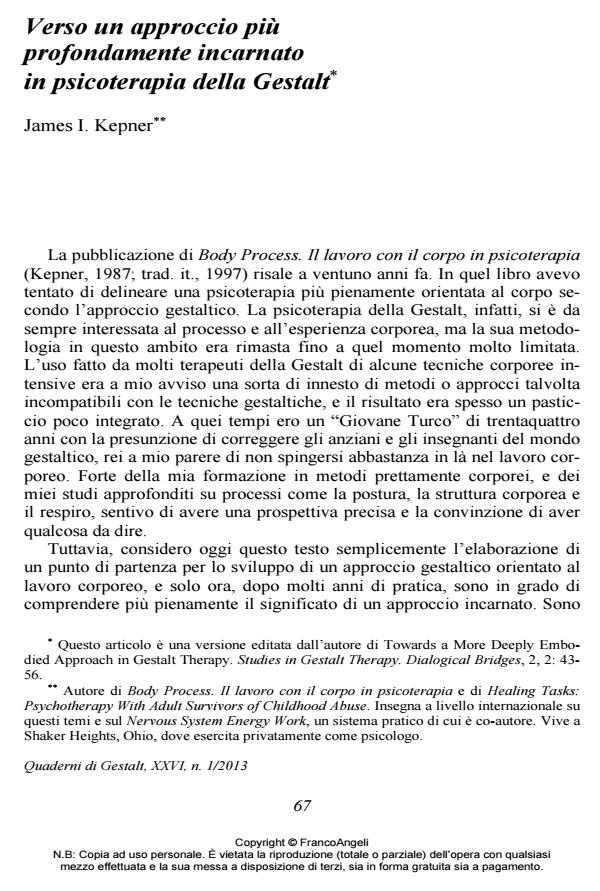Towards a More Deeply Embodied Approach in Gestalt Therapy
Journal title QUADERNI DI GESTALT
Author/s James I. Kepner
Publishing Year 2013 Issue 2013/1 Language Italian
Pages 14 P. 67-80 File size 361 KB
DOI 10.3280/GEST2013-001005
DOI is like a bar code for intellectual property: to have more infomation
click here
Below, you can see the article first page
If you want to buy this article in PDF format, you can do it, following the instructions to buy download credits

FrancoAngeli is member of Publishers International Linking Association, Inc (PILA), a not-for-profit association which run the CrossRef service enabling links to and from online scholarly content.
This article critiques and assesses the development of body-oriented work in gestalt therapy. Strengths of the gestalt therapy approach are highlighted as work with the actual, and holding an integral viewpoint. The author critiques limitations in the field involving a narrow epistemology of the founding perspective, the inadequacy of awareness alone for psychophysical change, the inclusion of structural concepts, and the need for physical methodology including touch and movement and other somatic methods. A brief model is offered for appreciating the multi-level complexity of a more fully embodied approach.
Keywords: Body-oriented work, gestalt therapy, epistemology, gestalt therapy training, non-dualistic approach, self, organism/environment field, figure/ground, structured ground, awareness, patterns and organization, developmental theory
- Bainbridge Cohen B., Nelson L., Smith N.S. (1993). Sensing, feeling, and action: The experiential anatomy of body-mind centering. Northampton, MA: Contact Editions.
- Frank R. (2001). Body of awareness: A somatic and developmental approach to psychotherapy. Cambridge, MA: Gestalt Press (trad. it.: Il corpo consapevole. Un approccio somatico ed evolutivo alla psicoterapia. Milano: FrancoAngeli, 2005).
- Kepner J.I. (1987). Body process: Working with the body in psychotherapy. Cleveland, OH: Gestalt Institute of Cleveland Press (trad. it.: Body Process. Il lavoro con il corpo in psicoterapia. Milano: FrancoAngeli, 1997).
- Kepner J.I. (2000). Gestalt approaches to body-oriented theory: An introduction. Gestalt Review, 4, 4: 262-266.
- Kepner J.I. (2003). Energy & the nervous system in embodied experience. Presented to the United States Association for Body Psychotherapy. Available for downloading at: http://www.pathwaysforhealing.com.
- Perls F.S. (1969). Ego, hunger and aggression. New York: Vintage Books (Originally published 1947) (trad. it.: L’io, la fame e l’aggressività. Milano: FrancoAngeli, 1995).
- Perls F., Hefferline R., Goodman P. (1951). Gestalt therapy: Excitement and growth in the human personality. New York: Julian Press (trad. it.: Teoria e pratica della terapia della Gestalt. Vitalità e accrescimento nella personalità umana. Roma: Astrolabio, 1997).
- Rubenfeld I. (2000). The Listening Hand. New York: Bantam.
- Wheeler G. (1996). Gestalt reconsidered: A new approach to contact and resistance. New York: Analytic Press (trad. it.: Che cos’è la terapia gestaltica. Un nuovo approccio al contatto e alla resistenza. Roma: Astrolabio, 1992).
- Wheeler G., McConville M. (Eds.) (2002; 2003). The heart of development: Gestalt approaches to working with children, adolescents, and their world. Childhood. Vol. 1. Adolescence. Vol. 2. NY: Routledge.
- Esperimento: estetica e reciprocità nella clinica contemporanea Luca Pino, in QUADERNI DI GESTALT 1/2021 pp.109
DOI: 10.3280/GEST2021-001012
James I. Kepner, Verso un approccio più profondamente incarnato in psicoterapia della Gestalt in "QUADERNI DI GESTALT" 1/2013, pp 67-80, DOI: 10.3280/GEST2013-001005